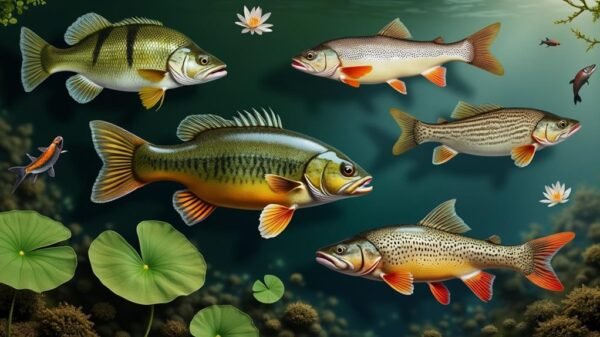Spotting freshwater fish is a rewarding challenge! Start by learning about common species like Largemouth Bass and Rainbow Trout. Pay attention to physical features, such as color patterns and fin shapes. Behavior matters too; look for schools of fish or signs of feeding activity. Fish often hide around rocks and plants, so search these habitats! Seasonal changes can shift their locations, so stay alert. Use field guides or a handy app to help with identification. Invest in binoculars for a closer look, and connect with local fishing communities for tips. There's so much more to discover, and you'll master it all!
Understanding Common Freshwater Species
When exploring typical freshwater ecosystems, you'll discover a variety of fish inhabiting lakes, rivers, and streams. Keep your eyes peeled for popular species such as Largemouth Bass, Rainbow Trout, and Channel Catfish. Each fish showcases unique traits and preferred environments, making your fishing trips more thrilling.
For example, Largemouth Bass and Black Crappie are among the most commonly encountered freshwater fish, abundant and highly sought after by anglers. Largemouth Bass are generally found in warmer waters, often lurking near natural structures like submerged trees or boulders. Their spirited nature will provide an exhilarating challenge when you try to catch them! In contrast, Rainbow Trout thrive in cooler waters of streams and rivers. Known for their striking coloration and quick movements, they can put up a tough fight when hooked.
Channel Catfish, identifiable by their long barbels, prefer deeper waters and are more active at night, making for exciting evening fishing adventures.
Be attentive to your surroundings! Watch for signs of fish activity, such as jumping or splashing, to identify the best fishing spots. By familiarizing yourself with these common fish species, you will enhance your fishing experiences and enjoy the beauty of the outdoors. Happy fishing!
Key Physical Features to Observe

When you're out on the lake, noticing essential physical traits of freshwater fish can significantly enhance your identification abilities. Start with the form; some species have a streamlined shape like a barracuda, while others are more robust, resembling a drum. This can help you differentiate between species. For instance, understanding that freshwater fish are divided into categories based on their preferred water temperatures can give context to their shapes.
Next, examine the fins. The variety in fin count and arrangement can be a clear indicator. For example, the dorsal fin may vary—some are tall and pointed like a sail, while others are broad and flat, much like a pancake.
Color plays a crucial role too. Freshwater fish exhibit striking hues and patterns that can easily attract attention. A Largemouth Bass might have dark vertical stripes, while a Rainbow Trout displays its characteristic speckled pattern. Additionally, consider the size! Recognizing the typical dimensions of a species can help narrow your choices when you encounter a larger specimen.
Behavioral Traits of Different Fish

Observing the behaviors of various freshwater species can reveal a lot about their habits and environments. Fish don't swim around aimlessly; they demonstrate distinct patterns that can help in identification. For example, note the schooling behavior. Species like minnows and largemouth bass often swim in groups, while others, like channel catfish, prefer solitude. Recognizing the diverse fishing experiences in lakes and ponds can aid in predicting where certain fish may be located based on their behaviors.
Additionally, observe feeding patterns. Some species, such as rainbow trout, tend to feed near the surface, often rising to snatch insects. Others, like common carp, root around the substrate in search of food, providing clues about their preferred habitats.
Aggression is another key behavior to watch. Certain species, including African cichlids, can be territorial, particularly during breeding seasons. If you observe fish chasing each other away, it's a strong indicator of a dominant species.
Identifying Fish by Habitat

Identifying fish by habitat boosts fishing success. Understanding fish preferences leads to better catch rates and time efficiency. Freshwater species inhabit diverse environments like lakes, rivers, ponds, and streams. Each ecosystem hosts unique species, making habitat knowledge essential. For example, in a slow-moving river, you may find catfish resting near the substrate, while Largemouth Bass often favor more dynamic waters. In shallow ponds, Bluegill can be plentiful, especially around aquatic vegetation. Specific fishing methods, such as using live bait or lures, enhance the experience in each habitat.
Water temperature and clarity significantly influence fish behavior and location.
Remember to scout for structures! Fish often conceal themselves around rocks, fallen timber, and submerged vegetation. These spots attract baitfish, which in turn draw larger predators like Pike and Walleye.
Seasonal changes also impact fish habitats. In spring, fish may migrate to shallow areas for spawning, while summer heat drives them to cooler depths. By mastering the habitats of various species, you'll elevate your angling skills and increase your chances of success.
Using Tools for Fish Identification

Understanding the aquatic environment isn't enough; having the right tools can simplify fish identification significantly. To begin, acquire a reliable field guide, such as the Peterson Field Guides or the FishBase app. These resources help you recognize various species by their hues, shapes, and dimensions. Opt for guides that specifically cover freshwater species, as they provide the most accurate details.
Next, invest in a quality pair of Nikon binoculars. These will enable you to observe fish from a distance without disturbing their ecosystem. This approach allows you to monitor their behavior and identify unique patterns that aid in recognition.
A smartphone camera, like the latest Apple iPhone or Samsung Galaxy, can be incredibly helpful as well. Taking photos of the fish you encounter allows for later comparison with your field guide. You may be surprised at how much easier it is to identify a fish when you can zoom in on specific features.
Lastly, consider joining a local fishing club or an online community, such as Fishbrain. Sharing your experiences and seeking assistance from fellow fishing enthusiasts can enhance your knowledge and confidence. With these resources in hand, you'll feel empowered to explore the world of freshwater fish and truly enjoy your time in nature.



























